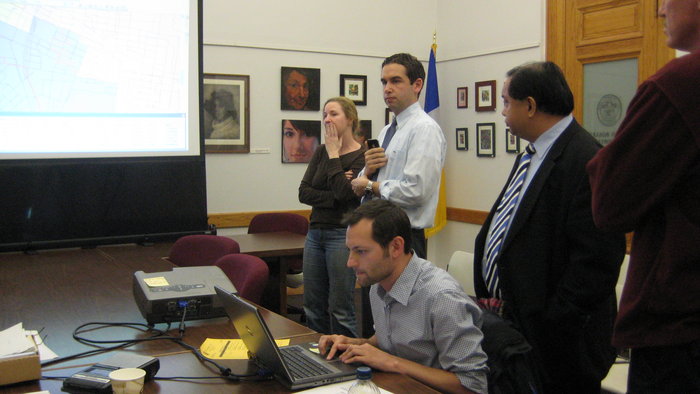The Jersey City Ward Commission will hold a public hearing this week and vote on a redrawn map of the city’s six municipal districts, a map that will significantly reduce the current size of downtown’s Ward E and increase Wards B, C, D, and F. Ward A will remain as is.
Redistricting is required due to the results of the latest U.S. Census, conducted in 2010, and is meant to divide the city’s population into six relatively equal municipal wards.
The Ward Commission met on Jan. 24 to begin the process of redrawing the ward boundaries so a public hearing and vote on the new map could be scheduled by the end of the month.
Several residents and activists attended the meeting, at which City Planner Jeff Wenger and City Clerk Robert Byrne adjusted ward boundaries on a projected computer screen in full view of residents. Residents’ suggestions at the meeting were incorporated into a tentative map that will be presented at this week’s public hearing.
About 6,840 Ward E residents will have to be shifted into one of the surrounding wards.
____________
“This is a minimal change that won’t affect the African American community’s ability to send a representative from their community to the City Council,” noted Byrne.
But the proposed change will divide the historic neighborhood of Van Vorst Park, which Wenger conceded, “is a concern.”
Some who attended the meeting quietly questioned whether this change will affect that community’s ability to have specific concerns – such as the ongoing flooding issue – addressed if the neighborhood is split into two wards.
Why now?
The 2010 U.S. Census found that Jersey City’s current population is 247,597 and results of the population survey were released months ago. Thus, the redistricting process should have been completed last year. However, Jersey City is challenging the results of the census on the grounds that many high-rise housing units – and by extension, thousands of residents – were not included in the official count.
Last September, a Hudson County Superior Court judge granted the city an extension to complete its redistricting while it awaits a decision on its census challenge. However, the U.S. Census Bureau has yet to rule on the city’s challenge. The city could request another extension, but with the next regularly scheduled municipal elections set for May 2013, the clock is ticking.
“The Census Bureau can’t tell us if and when they will correct the population numbers,” Byrne said. “We have already seen state legislative boundaries redrawn. We have already seen congressional boundaries redrawn. We can’t wait any longer. We might not be on good footing to get another extension given that the next municipal election in Jersey City is in May of 2013. For people to qualify to run [for City Council] in the various wards, they have to live in the ward for at least one year prior to the election. So, in all fairness, redistricting has to move now.”
The proposed map drawn up by the Ward Commission last week keeps all of the current City Council members in their current wards.
Cutting down to size
The ideal target population for each ward is 41,266 residents, although the law allows a margin of plus or minus 5 percent. This means each ward must have between 39,203 and 43,329 residents.
Because much of Jersey City’s population growth over the last decade has been largely concentrated downtown, Ward E currently has a population of 49,640 residents, according to the census, a number city officials believe is low. Given this growth, 40 city blocks – and about 6,840 residents – currently in Ward E will have to be shifted into one of the surrounding wards that currently has too few residents.
“The [Jersey City Division of Planning] assumes that post-contested numbers will boost the Ward E population even further out of compliance, since this is where the missing high-rise buildings are,” according to Wenger. “With a more accurate overall population count…and a higher total population for the city, Ward E may have to shrink even further.”
According to the tentative map the Ward Commission will present at the public hearing this week, Ward F will extend as far north as Jersey and Montgomery. Currently, Ward F has too few residents – 38,973 – to be in compliance with the law. A portion of the community around Ferris High School and Columbus Avenue would also be added to Ward F.
“We try to make an effort to respect and retain the historical identity and makeup of a community,” Byrne said. “We also try to respect certain natural boundaries – for example the Turnpike or major streets or thoroughfares. But nothing about this map is written in stone. If people at the public hearing come up with a cogent argument for doing something different, we can do it as long as we’re in compliance with the law.”
The public hearing on the proposed map will be held Tuesday, Jan. 31 at 6 p.m. City Hall, 280 Grove St.
E-mail E. Assata Wright at awright@hudsonreporter.com.
